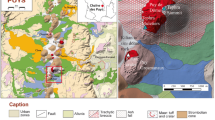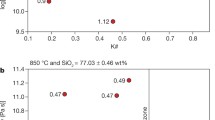Abstract
Basaltic lavas collected at the Muliwai a Pele lava channel, built during 1974 as part of Mauna Ulu’s eruption on Kilauea’s east rift zone, have been studied to investigate the effect of cooling and crystallization on the rheological properties of the lava. We have quantified the viscosity-strain-rate dependence of lava during cooling and crystallization, using concentric cylinder viscometry. We measured the viscosity of the crystal-free liquid between 1600 and 1230 °C, where we observed a deviation from the expected viscosity trend, marking the liquidus. We then made rheology measurements at subliquidus temperatures of 1207, 1203, 1183, 1176, and 1169 °C, varying the applied strain rates at each temperature. While the crystal-free liquid behaved as a Newtonian fluid, crystallization changed the rheological response to pseudo-plastic behavior, even at the lowest crystal volume fraction of 0.025. Pseudo-plastic behavior was observed down to a temperature of 1183 °C, with a crystal fraction of 0.15. Between 1183 and 1176 °C, the two-phase suspension transitioned from a power-law fluid to a Herschel-Bulkley fluid. At temperatures of 1176 and 1169 °C, with crystal fractions of 0.33 and 0.42, respectively, we observed lobate surface textures on the experimental samples, which remained preserved until the end of the experiments. Measurements at these temperatures indicated yield strengths of 82 ± 16 and 238 ± 18 Pa, respectively. The yield strength resulted from the development of an interconnected crystal network of diopside and enstatite by 1176 °C. By 1169 °C, diopside and plagioclase microcrystals had also appeared, and the effective viscosity was between 2000 and 5000 Pa s, depending on the strain rate. Further cooling to 1164 °C resulted in a rapid viscosity increase, to an effective viscosity in excess of 105 Pa s that exceeded the measurement range of our apparatus. The yield strength varies with crystallinity in an exponential fashion, with yield strength in Pa given by σ y = 1.25e12.93Φ c, where Φ c is the crystal volume fraction. The physical effect of crystals on the relative viscosity of magma was assessed by removing the effects of changing residual liquid viscosity, due to changing composition and temperature. To do this, we analyzed, synthesized, and measured the most evolved residual liquid from the subliquidus experiments. The effect of crystals was best captured by the Einstein-Roscoe equation for polydisperse spherical inclusions. We also measured the viscosity of the same crystal-liquid mixtures at low temperatures and strain rates using parallel-plate viscometry. The effect of crystals on magma viscosity was slightly greater at low strain rates, in agreement with theoretical models, although no single model reproduced these results well. In our experiments, the transition from pahoehoe to `a`a occurred between 1200 and 1170 °C, at viscosities between 100 and 1000 Pa s, depending on strain rate.


















Similar content being viewed by others
References
Armstrong JT (1995) CITZAF: a package of correction programs for the quantitative electron microbeam X-ray analysis of thick polished materials, thin films, and particles. Microbeam Anal 4:177–200
Avard G, Whittington AG (2012) Rheology of arc dacite lavas: experimental determination at low strain rates. Bull Volcanol 74:1039–1056. doi:10.1007/s00445-012-0584-2
Calvari A, Pinkerton H (1998) Formation of lava tubes and extensive flow field during the 1991–1993 eruption of Mount Etna. J Geophys Res 103(B11):27291–27301
Cashman KV, Thornber C, Kauahikaua JP (1999) Cooling and crystallization of lava in open channels, and the transition of Pāhoehoe Lava to `A`a. Bull Volcanol 61(5):306–323
Costa A, Caricchi L, Bagdassarov N (2009) A model for the rheology of particle-bearing suspensions and partially molten rocks. Geochem Geophys Geosyst 10(3)
Dingwell DB (1995) Viscosity and anelasticity of melts. In: Mineral physics and crystallography: a handbook of physical constants. AGU, Washington, DC, pp 209–217
Dingwell DB, Virgo D (1988) Melt viscosities in the Na2O–FeO–Fe2O3–SiO2 system and factors controlling the relative viscosities of fully polymerized silicate melts. Geochim Cosmochim Acta 52:395–403
Dutton C (1884) Hawaiian Volcanoes. U.S. Geological Survey 4th Ann. Rept.:75–219
Einstein A (1911) Berichtigung zu meiner Arbeit: eine neue bestimmung der moleküldimension. Ann Phys 339(3):1521–3889. doi:10.1002/andp.19113390313
Getson JM, Whittington AG (2007) Liquid and magma viscosity in the anorthite-forsterite-diopside-quartz system and implications for the viscosity-temperature paths of cooling magmas. J Geophys Res 112(B10)
Giordano D, Russell JK, Dingwell DB (2008) Viscosity of magmatic liquids: a model. Earth Planet Sci Lett 271(1–4):123–134
Guth E, Gold O (1938) On the hydrodynamical theory of the viscosity of suspensions. Phys Rev 53(322)
Harris AJL, Allen JS III (2008) One-, two- and three-phase viscosity treatments for basaltic lava flows. J Geophys Res 113, B09212
Harris AJL, Favalli M, Mazzarini F, Hamilton CW (2009) Construction dynamics of a lava channel. Bull Volcanol 71:459–474
Helz R, Thornber C (1987) Geothermometry of Kilauea Iki lava lake, Hawaii. Bull Volcanol 49(5):651–668
Hon K, Gansecki C, Kauahikaua JP (2003) The transition from `A`a to Pahoehoe Crust on Flows Emplaced During the Pu‘u ‘Ō‘ō-Kūpaianaha Eruption. U.S. Geological Survey Professional Paper (1676):89–104
Hoover SR, Chasman KV, Manga M (2001) The yield strength of subliquidus basalts—experimental results. J Volcanol Geotherm Res 107:1–18
Ishibashi H (2009) Non-Newtonian behavior of plagioclase-bearing basaltic magma: subliquidus viscosity measurement of the 1707 basalt of Fuji volcano, Japan. J Volcanol Geotherm Res 181:78–88
Ishibashi H, Sato H (2007) Viscosity measurements of subliquidus magmas: alkali olivine basalt from the Higashi-Matsuura district, Southwest Japan. J Volcanol Geotherm Res 160(3–4):223–238
Ishibashi H, Sato H (2010) Bingham fluid behavior of plagioclase-bearing basaltic magma: reanalyses of laboratory viscosity measurements for Fuji 1707 basalt. J Mineral Petrol Sci 105(6):334–339
Kerr RC, Lister JR (1991) The effects of shape on crystal settling and on the rheology of magmas. J Geol 99(3):457–467
Keszthelyi L, Self S (1998) Some physical requirements for the emplacement of long basaltic lava flows. J Geophys Res Solid Earth 103(B11):2156–2202
Kilburn CRJ (1981) Pahoehoe and aa lavas: a discussion and continuation of the model of Peterson and Tilling. J Volcanol Geotherm Res 11(2–4):373–382
Kilburn CRJ (1987) Rheological implications of the pahoehoe-aa transition in lavas. Abstr. International Union of Geodesy and Geophysics
Krieger I, Dougherty T (1959) A mechanism for non-Newtonian flow in suspensions of rigid spheres. Trans Soc Rheol 3:137–152
Macdonald GA (1953) Pahoehoe, aa, and block lava. Am J Sci 251(3):169–191
Mader HM, Llewellin EW, Mueller SP (2013) The rheology of two-phase magmas: a review and analysis. J Volcanol Geotherm Res 257:135–158
Marsh BD (1981) On the crystallinity, probability of occurrence, and rheology of lava and magma. Contrib Mineral Petrol 78(1):85–98
Mueller S, Llewellin EW, Mader HM (2010) The rheology of suspensions of solid particles. Proc R Soc A Math Phys Eng Sci 466(2116):1201–1228
Peterson DW, Tilling RI (1980) Transition of basaltic lava from pahoehoe to aa, Kilauea Volcano, Hawaii: field observations and key factors. J Volcanol Geotherm Res 7(3–4):271–293
Putirka KD (2008) Thermometers and barometers for volcanic systems. Rev Mineral Geochem 69(1):61–120
Robert B, Harris AJ, Gurioli L, Medard E, Sehlke A, Whittington AG (2014) Textural and rheological evolution of basalt flowing down a lava channel. Bull Volcanol 76(6):824. doi:10.1007/s00445-014-0824-8
Roscoe R (1952) The viscosity of suspensions of rigid spheres. J Appl Phys 2:267–269
Rowland S, Walker G (1990) Pahoehoe and aa in Hawaii: volumetric flow rate controls the lava structure. Bull Volcanol 52(8):615–628
Rust AC, Manga M (2002) Bubble shapes and orientations in low re simple shear flow. J Colloid Interface Sci 249(2):476–480
Ryerson FJ, Weed HC, Piwinskii AJ (1988) Rheology of subliquidus magmas: 1. Picritic compositions. J Geophys Res Solid Earth 93(B4):3421–3436
Sato H (1995) Textural difference between pahoehoe and aa lavas of Izu-Oshima volcano, Japan—an experimental study on population density of plagioclase. J Volcanol Geotherm Res 66(1–4):101–113
Schuessler JA, Botcharnikov RE, Behrens H, Misiti V, Freda C (2008) Amorphous materials: properties, structure, and durability: oxidation state of iron in hydrous phono-tephritic melts. Am Mineral 93(10):1493–1504
Soule SA, Cashman KV (2005) Shear rate dependence of the pahoehoe to `a`a transition: analog experiments. Geology 33:361–364
Stein DJ, Spera FJ (1998) New high-temperature rotational rheometer for silicate melts, magmatic suspensions, and emulsions. Rev Sci Instrum 69:3398–3402. doi:10.1063/1.1149106
Vogel DH (1921) Temperaturabhängigkeitsgesetz der Viskosität von Flüssigkeiten. Phys Z XXII:645–646
Vona A, Romano C, Dingwell DB, Giordano D (2011) The rheology of crystal-bearing basaltic magmas from Stromboli and Etna. Geochim Cosmochim Acta 75(11):3214–3236
Whittington AG, Hellwig BM, Behrens H, Joachim B, Stechern A, Vetere, F (2009) The viscosity of hydrous dacitic liquids: Implications for the rheology of evolving silicic magmas. Bull Volcanol 71:185–199. doi:10.1007/s00445-008-0217-y
Wilson AD (1960) The micro-determination of ferrous iron in silicate minerals by a volumetric and a colorimetric method. Analyst 85(1016):823–827
Acknowledgments
This work was supported by NSF award EAR-1220051 and NASA grant NNX12AO44G to AW. Travel funding to AS for field work was granted by AGU (via NSF) and the University of Missouri-Graduate Student Association (GSA) and Graduate Professional Council (GPC), as well as the Department of Geological Sciences. We thank Hawai’i Volcanoes National Park for a research permit and Paul Carpenter for assistance with microprobe analyses. BR, AH, LG and EM was financed by the French Government Laboratory of Excellence initiative n°ANR-10-LABX-0006, the Région Auvergne and the European Regional Development Fund. This is Laboratory of Excellence ClerVolc contribution number 124.
Author information
Authors and Affiliations
Corresponding author
Additional information
Editorial responsibility: M. Manga
Electronic supplementary material
Below is the link to the electronic supplementary material.
ESM 1
Calculated moles of cations to the number of oxides of identified mineral phases of the subliquidus samples (DOCX 79 kb)
Rights and permissions
About this article
Cite this article
Sehlke, A., Whittington, A., Robert, B. et al. Pahoehoe to `a`a transition of Hawaiian lavas: an experimental study. Bull Volcanol 76, 876 (2014). https://doi.org/10.1007/s00445-014-0876-9
Received:
Accepted:
Published:
DOI: https://doi.org/10.1007/s00445-014-0876-9




